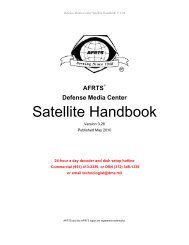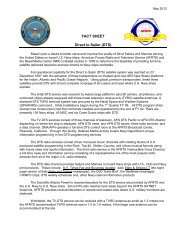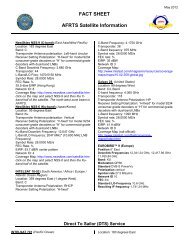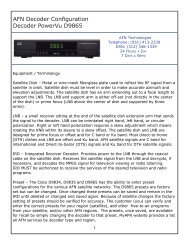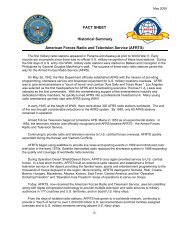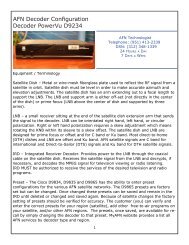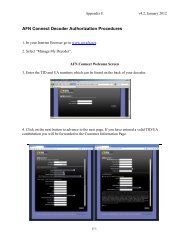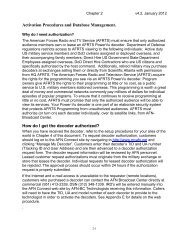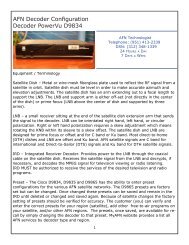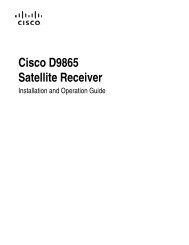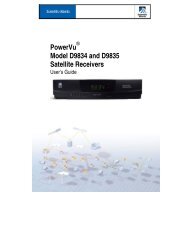Digital Satellite Downlink Reception - American Forces Radio and ...
Digital Satellite Downlink Reception - American Forces Radio and ...
Digital Satellite Downlink Reception - American Forces Radio and ...
You also want an ePaper? Increase the reach of your titles
YUMPU automatically turns print PDFs into web optimized ePapers that Google loves.
Defense Media Center <strong>Satellite</strong> H<strong>and</strong>book V.3.26<br />
These interfering carriers are usually out-of-b<strong>and</strong> <strong>and</strong> can be dealt with by<br />
installing a C-b<strong>and</strong> block filter that can be specifically manufactured for greater<br />
protection at the aircraft radar frequency.<br />
Other potential sources of interference from airports are ground looking radar<br />
that can saturate LNA/LNB’s. Frequency coordination in some countries allow for<br />
adjacent b<strong>and</strong>s to be utilized where they can cause out-of-b<strong>and</strong> interference.<br />
Once again, C-b<strong>and</strong> b<strong>and</strong> pass or block filters remain an effective means of<br />
controlling the interfering carrier.<br />
Ship-board Radar<br />
Another potential source of interference in coastal areas is shipboard naval<br />
radar. Usually, this on-board radar is not supposed to be utilized within a radius<br />
of the shore; however, there are documented cases where this radar has been<br />
“turned on” with deleterious effects to the local coastal viewing audience.<br />
Commercial Microwave Ovens<br />
Commercial microwave ovens operating in fast-food chains <strong>and</strong> earth station<br />
lunchrooms are potential sources of interference. Emissions levels allowed by a<br />
microwave oven can be as much as 20 dB higher than a C-b<strong>and</strong> satellite carrier;<br />
however, microwave oven manufactures are normally required to replace units<br />
that are known to interfere with commercial broadcast systems. A typical<br />
operating frequency for a microwave oven is 2250 MHz with a considerable<br />
amount of wide b<strong>and</strong> noise generated in the 3900 MHz to 4500 MHz range. This<br />
noise can become more apparent over the life of the magnetron <strong>and</strong> can be<br />
prevalent near the end of its useful life.<br />
Walkie-Talkies<br />
Walkie-talkies have been observed to interfere with the operation of IRDs.<br />
Operating a walkie-talkie in the vicinity of the IRD can interfere with the operation<br />
of the IRD. Restricted use of walkie-talkies is recommended in the vicinity of a<br />
downlink earth station.<br />
Cell Phones<br />
Cell (Cellular) Telephones operate in the 900 Mhz range <strong>and</strong> can directly<br />
interfere with the down converted (IF) signal from the LNB to the IRD. The<br />
activation of a cell phone unit near the IRD may generate unacceptable<br />
destructive or out of b<strong>and</strong> interference which may enter the IRD through poorly<br />
shielded cabling or improperly terminated dividers <strong>and</strong> connectors.<br />
R<strong>and</strong>om RFI (Fluorescent <strong>and</strong> Sodium Vapor Lamps, Lightning)<br />
Particularly on start-up, fluorescent lamps can flicker causing an interfering<br />
source to an earth station antenna nearby. Another potential source is sodium<br />
vapor lamps when in a “failed” condition. Lightning is another known source of<br />
RFI that can effectively wipeout both digital <strong>and</strong> analog carriers. Though these<br />
sources are not a common occurrence, they should be mentioned in the<br />
investigation of a RFI occurrence.<br />
4-16



